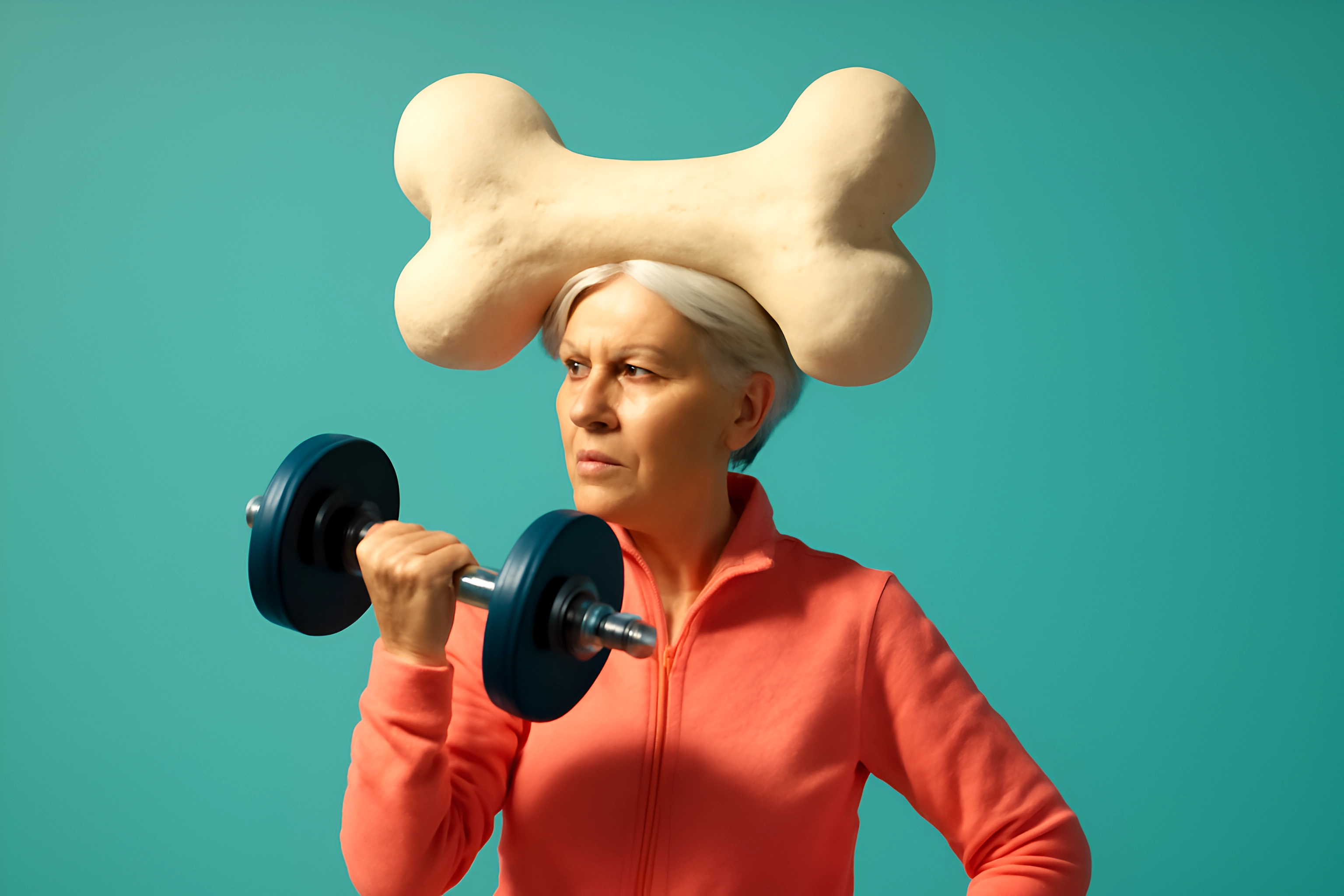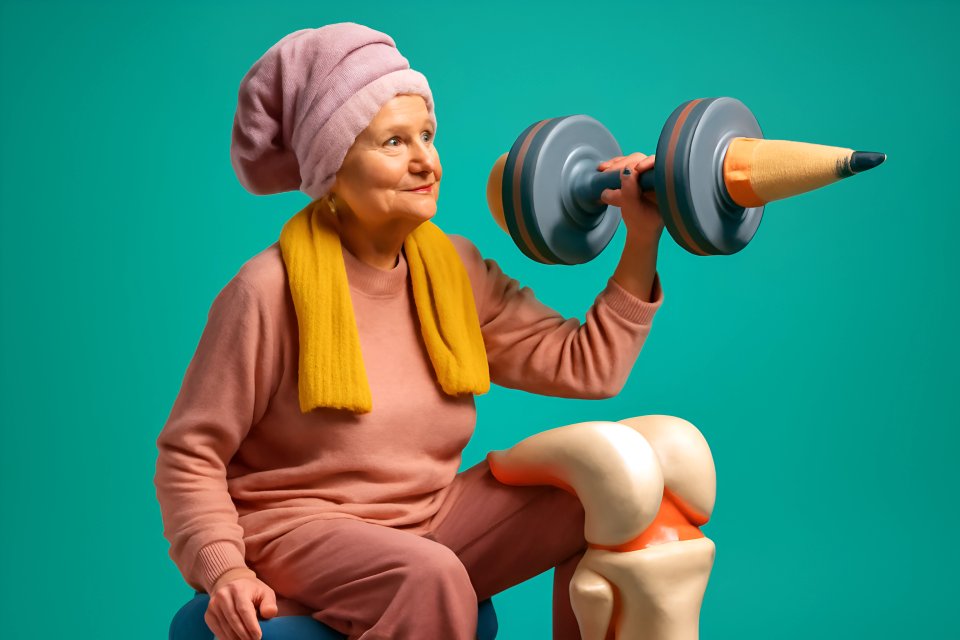
Introduction: You're Not Alone—Let's Tackle This Together
Does it feel like your body has a new set of rules? You're eating the same, moving the same, but the scale is creeping up, and a stubborn layer has settled around your midsection. If you're navigating perimenopause or menopause, you are not imagining it, and you are certainly not alone in this frustrating battle.
This isn't a personal failure or a sign that you've lost your discipline. This is a biological shift, a profound change orchestrated by your hormones that rewrites the playbook for weight management. The old strategies of "eat less, move more" suddenly feel ineffective, leaving you feeling powerless and disconnected from the body you've known for decades.
But here is the powerful truth: you can reclaim control. The solution lies in a science-backed, two-pronged approach that works with your changing body, not against it. By combining targeted strength training for menopause weight gain with strategic nutrition tips for menopause weight management, you can build a stronger, more resilient, and metabolically active body for this new chapter of your life.
Why Does Menopause Cause Weight Gain? The Hormonal Connection
To win this battle, you first need to understand the battlefield. The weight gain that often accompanies menopause isn't just about calories; it's a complex interplay of hormonal changes that fundamentally alters how your body uses and stores energy. Understanding this "why" is the first step toward taking back your power.
The primary driver is the decline in estrogen. This powerful hormone does more than regulate your cycle; it also influences where your body stores fat. As estrogen levels drop, your body tends to shift fat storage from the hips and thighs to the abdomen, leading to an increase in visceral fat—the dangerous type that surrounds your organs. According to experts at University Hospitals, this hormonal shift also contributes to a slower metabolism, making it easier to gain weight even without changing your diet.
Compounding this is the natural age-related loss of muscle mass, a condition known as sarcopenia, which menopause accelerates. Muscle is your body's metabolic engine; the more you have, the more calories you burn, even at rest. As you lose this precious muscle tissue, your metabolic rate slows down, creating a perfect storm for weight gain. This is why strength training is not just beneficial but essential, as it directly counteracts this muscle loss and helps preserve your metabolic furnace.
Finally, lifestyle factors common during this transition play a significant role. Menopause often disrupts sleep and increases stress, leading to elevated levels of the stress hormone, cortisol. High cortisol is notorious for promoting belly fat storage and increasing cravings for high-sugar, high-fat foods. These hormonal shifts can also lead to increased insulin resistance, making it harder for your body to manage blood sugar and further encouraging fat storage.
Why Strength Training is Your Best Ally for Menopause Weight Management
If hormonal changes are the problem, then building muscle is the single most effective solution you can deploy. Cardio is great for your heart, but when it comes to reshaping your body and revving up your metabolism during menopause, strength training is the undisputed champion. It directly addresses the root causes of menopausal weight gain in ways that no other form of exercise can.
The most significant benefit is its impact on your metabolism. By building lean muscle, you increase your resting metabolic rate, meaning your body burns more calories 24/7, even while you're reading a book or sleeping. Research from Hydrow explains that strength training also stimulates muscle-building stem cells, which decline with lower estrogen, helping you regenerate and maintain that precious, calorie-torching muscle mass.
Beyond metabolism, strength training is your best defense against osteoporosis. The mechanical stress of lifting weights signals your body to build stronger, denser bones, which is critical as declining estrogen makes bones more vulnerable. A comprehensive 2023 review published by the National Institutes of Health confirmed that strength exercises significantly improve bone density in menopausal women. This is about more than weight; it's about building a robust, fracture-proof frame for a long and active life.
Furthermore, resistance training dramatically improves your body's ability to handle sugar by enhancing insulin sensitivity. This helps prevent the blood sugar spikes and crashes that lead to cravings and fat storage. As explained by Jayla Health, this improvement in insulin sensitivity is a key reason weight training is so effective for reducing dangerous visceral fat and improving overall cardiovascular health.
Your Foundational Strength Training Routine (2-3 Times Per Week)
Getting started doesn't require hours in a gym. A simple, consistent routine performed at home two to three times per week can deliver incredible results. Focus on compound movements that work multiple muscle groups at once for maximum efficiency.
Warm-up (5 minutes):
Begin with light cardio like marching in place or jogging on the spot. Follow with dynamic stretches such as arm circles, torso twists, and leg swings to prepare your muscles and joints for work.
The Workout:
Perform each exercise with controlled movements.
- Goblet Squats (or Bodyweight Squats): 3 sets of 8-12 reps. This powerhouse move targets your entire lower body and core, building functional strength for everyday life.
- Modified Push-ups (on knees or against a wall): 3 sets to your personal best. This builds strength in your chest, shoulders, and arms, improving upper body tone and posture.
- Dumbbell Rows: 3 sets of 8-12 reps per arm. This is crucial for building a strong back to support good posture and combat the "midlife stoop."
- Glute Bridges: 3 sets of 12-15 reps. This activates your glutes and hamstrings, which helps support your lower back and improve hip stability.
- Plank: 3 sets, hold for 20-45 seconds. This targets the deep core muscles essential for a stable spine and a flatter-looking midsection.
Cool-down (5 minutes):
Finish with static stretches, holding each for 20-30 seconds. Focus on the major muscle groups you just worked, such as your quads, hamstrings, chest, and back.
Tips for Success and Safety
Starting a new routine can feel intimidating, but your primary goal is consistency, not intensity. Begin with weights that feel challenging but manageable, or simply use your own body weight. The last two repetitions of each set should feel difficult, but not impossible.
Proper form is far more important than lifting heavy. Watch videos of each exercise to understand the correct movement patterns, or consider a session with a personal trainer to get started safely. This focus on form will prevent injury and ensure you're targeting the right muscles for the best results.
Finally, listen to your body. Rest and recovery are when your muscles actually repair and grow stronger. Don't be afraid to take an extra day off if you're feeling sore. For more guidance on getting started, explore our guide on Adaptive Resistance Training for Seniors: A Gentle Guide to Maintaining Muscle Strength Over 50.
Nutrition That Works With Your Body, Not Against It
You cannot out-train a poor diet, especially during menopause. The food you eat is the fuel that supports muscle growth, balances hormones, and provides the energy you need to thrive. It's time to shift your focus from restriction to nourishment with a few key principles.
Prioritize Protein
Protein is the single most important macronutrient for women over 50. It provides the building blocks necessary to repair and build the lean muscle you're working so hard for in your strength training sessions. Without adequate protein, your efforts will be far less effective.
A higher protein intake also boosts your metabolism, as your body burns more calories digesting protein than it does fats or carbs. Furthermore, protein is incredibly satiating, helping you feel fuller for longer and reducing the cravings that can derail your progress.
Aim to include a solid source of protein in every meal, shooting for roughly 20-30 grams. Excellent sources include lean chicken, fish, eggs, Greek yogurt, cottage cheese, tofu, lentils, and quality protein powder.
Fill Up on Fiber
Fiber is your secret weapon for managing blood sugar and promoting gut health. It slows down digestion, which prevents the sharp spikes and subsequent crashes in blood sugar that can lead to energy slumps and cravings. This stabilization is crucial for managing insulin resistance.
Fiber-rich foods are also voluminous and low in calories, helping you feel full and satisfied with your meals. This makes it easier to naturally manage your calorie intake without feeling deprived.
Load your plate with non-starchy vegetables like leafy greens, broccoli, bell peppers, and cauliflower. Incorporate berries, legumes, and whole grains like quinoa and oats to ensure you're getting a diverse range of fiber.
Embrace Healthy Fats
Fat does not make you fat—in fact, the right kinds of fats are essential for your health during menopause. Healthy fats are critical for the production of hormones, reducing inflammation throughout the body, and absorbing fat-soluble vitamins.
Inflammation is a key contributor to many chronic diseases and can make weight loss more difficult. Anti-inflammatory fats can help cool this internal fire, supporting your overall health and well-being.
Incorporate sources like avocado, nuts, seeds (chia, flax, hemp), and extra virgin olive oil into your daily diet. Fatty fish like salmon is also an excellent source of omega-3 fatty acids, which are particularly beneficial for brain and heart health.
Be Smart with Carbs
Carbohydrates are not the enemy, but the type of carbohydrate you choose matters immensely. Your body needs carbs for energy, especially to fuel your workouts. The key is to choose complex, slow-digesting carbs over simple, refined ones.
Simple sugars and refined carbs (found in white bread, pastries, and sugary drinks) cause a rapid spike in blood sugar, triggering a large insulin release and promoting fat storage. This is the exact cycle you want to avoid.
Instead, opt for complex carbohydrates that are high in fiber, such as sweet potatoes, quinoa, brown rice, oats, and beans. These provide a slow, steady release of energy that will fuel your body and keep you feeling satisfied for hours.
How Nutrition and Strength Training Work Together for Optimal Results
Think of strength training and nutrition as two sides of the same coin; one cannot be fully effective without the other. When you combine them strategically, you create a powerful synergy that accelerates your results and transforms your health from the inside out. The magic happens when these two powerful strategies are applied consistently.
Your nutrition directly fuels your fitness efforts. Consuming a small, easily digestible snack with carbohydrates about 30-60 minutes before your workout can provide the quick energy you need to push through your sets with strength and focus. This ensures you get the most out of every single repetition.
Even more critical is your post-workout nutrition. After you challenge your muscles with resistance training, they are primed for repair and growth. Consuming a protein-rich meal or snack within an hour or two after your workout provides the essential amino acids your muscles need to rebuild stronger than before, maximizing the metabolic benefits of your session.
Mindful Aging: Lifestyle Tweaks That Make a Big Difference
While fitness and nutrition are the cornerstones of managing menopausal weight gain, a holistic approach that includes key lifestyle habits can amplify your success. These mindful tweaks help regulate the hormones, like cortisol, that play such a significant role in midlife weight gain.
Prioritizing sleep is non-negotiable. Aim for 7-9 hours of quality sleep per night, as this is when your body repairs itself and regulates crucial hormones. Poor sleep is directly linked to higher cortisol levels and increased appetite, a combination that makes weight management nearly impossible. For actionable tips, see our guide on Mindful Habits for Better Sleep: Evening Routines for 50+ Wellness.
Similarly, finding effective ways to manage stress is essential for lowering cortisol. This doesn't require a massive life overhaul; simple practices can make a world of difference. Incorporate activities like deep breathing exercises, a quiet walk in nature, meditation, or journaling into your daily routine. Learn more about Stress-Free Living Over 50: Integrative Approaches Combining Diet, Exercise, and Mindfulness.
Finally, pay attention to hydration and limit substances that can exacerbate your symptoms. Drinking plenty of water is crucial for boosting metabolism and maintaining energy levels. At the same time, be mindful of alcohol and excess sugar, as they can disrupt sleep, trigger hot flashes, and contribute empty calories that lead directly to fat storage.
Conclusion: Your Journey to a Stronger, Healthier You
The changes that come with menopause can feel overwhelming, but they do not have to define you or your health. Remember, the weight gain you're experiencing is not a reflection of your effort but a result of a significant hormonal shift. The solution is to adapt your strategy with the powerful combination of strength training, protein- and fiber-rich nutrition, and mindful lifestyle habits.
This is more than a weight loss plan; it's a blueprint for building the strongest, most vital version of yourself for the decades to come. By embracing these practical strategies, you're not just managing weight—you're investing in your long-term health, vitality, and confidence. You have the tools, you have the knowledge, and you have the strength. You've got this.
What's one change you're excited to try? Share your thoughts and questions in the comments below—we love hearing from our community!
For more tips on thriving after 50, check out our other articles on Combining Resistance and Flexibility: A Balanced Strength Training Program for Over 50 and discover How to Optimize Daily Activity Levels for Better Metabolism After 50.















